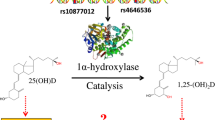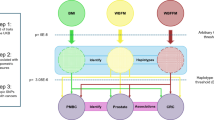Abstract
Object:
To examine the relationship between genetic polymorphisms of the CYP19A1 gene and obesity-related phenotypes, body mass index (BMI) and waist-to-hip ratio (WHR).
Subjects:
In total, 1241 Chinese women, who were recruited as community controls for a population-based case–control study of breast cancer.
Methods:
Nineteen haplotype tagging single nucleotide polymorphisms (htSNPs) in four haplotype blocks were genotyped.
Results:
Significant associations were observed for WHR at three SNPs that are located in haplotype block 1, including rs2445765, rs1004984 and rs1902584 (P=0.05, 0.04 and 0.01, respectively). Women, particularly premenopausal women, who carried the minor allele at any of these SNPs, had higher WHR than those without it. Of these three SNPs, the strongest association was observed at rs1902584, which is the closest to Promoter I.4, the major promoter for adipose tissue. Haplotype analyses indicated an association between the haplotype TCCAT in block 1 and WHR with a P-value of 0.02.
Conclusion:
These results suggested that CYP19A1 genetic polymorphisms may be associated with the risk of obesity among Chinese women, especially among premenopausal women.
The CYP19A1 protein (aromatase) plays a critical role in estrogen biosynthesis and thus affects body fat distribution and regulation.
This is a preview of subscription content, access via your institution
Access options
Subscribe to this journal
Receive 12 print issues and online access
$259.00 per year
only $21.58 per issue
Buy this article
- Purchase on Springer Link
- Instant access to full article PDF
Prices may be subject to local taxes which are calculated during checkout

Similar content being viewed by others
References
Kopelman PG . Obesity as a medical problem. Nature 2000; 404: 635–643.
Seidell JC . Obesity: a growing problem. Acta Paediatr Suppl 1999; 88: 46–50.
Bjorntorp P . Metabolic difference between visceral fat and subcutaneous abdominal fat. Diabetes Metab 2000; 26: 10–12.
Liu YJ, Araujo S, Recker RR, Deng HW . Molecular and genetic mechanisms of obesity: implications for future management. Curr Mol Med 2003; 3: 325–340.
Nelson TL, Brandon DT, Wiggins SA, Whitfield KE . Genetic and environmental influences on body-fat measures among African-American twins. Obes Res 2002; 10: 733–739.
Perusse L, Rankinen T, Zuberi A, Chagnon YC, Weisnagel SJ, Argyropoulos G et al. The human obesity gene map: the 2004 update. Obes Res 2005; 13: 381–490.
McTernan PG, Anwar A, Eggo MC, Barnett AH, Stewart PM, Kumar S . Gender differences in the regulation of P450 aromatase expression and activity in human adipose tissue. Int J Obes Relat Metab Disord 2000; 24: 875–881.
Armellini F, Zamboni M, Bosello O . Hormones and body composition in humans: clinical studies. Int J Obes Relat Metab Disord 2000; 24 (Suppl 2): S18–S21.
Anderson LA, McTernan PG, Barnett AH, Kumar S . The effects of androgens and estrogens on preadipocyte proliferation in human adipose tissue: influence of gender and site. J Clin Endocrinol Metab 2001; 86: 5045–5051.
De Pergola G . The adipose tissue metabolism: role of testosterone and dehydroepiandrosterone. Int J Obes Relat Metab Disord 2000; 24 (Suppl 2): S59–S63.
Dieudonne MN, Pecquery R, Leneveu MC, Giudicelli Y . Opposite effects of androgens and estrogens on adipogenesis in rat preadipocytes: evidence for sex and site-related specificities and possible involvement of insulin-like growth factor 1 receptor and peroxisome proliferator-activated receptor gamma2. Endocrinology 2000; 141: 649–656.
Jones ME, Thorburn AW, Britt KL, Hewitt KN, Wreford NG, Proietto J et al. Aromatase-deficient (ArKO) mice have a phenotype of increased adiposity. Proc Natl Acad Sci USA 2000; 97: 12735–12740.
Meyre D, Lecoeur C, Delplanque J, Francke S, Vatin V, Durand E et al. A genome-wide scan for childhood obesity-associated traits in French families shows significant linkage on chromosome 6q22.31–q23.2. Diabetes 2004; 53: 803–811.
Martin LJ, Cianflone K, Zakarian R, Nagrani G, Almasy L, Rainwater DL et al. Bivariate linkage between acylation-stimulating protein and BMI and high-density lipoproteins. Obes Res 2004; 12: 669–678.
Chagnon YC, Borecki IB, Perusse L, Roy S, Lacaille M, Chagnon M et al. Genome-wide search for genes related to the fat-free body mass in the Quebec family study. Metabolism 2000; 49: 203–207.
Gao YT, Shu XO, Dai Q, Potter JD, Brinton LA, Wen W et al. Association of menstrual and reproductive factors with breast cancer risk: results from the Shanghai Breast Cancer Study. Int J Cancer 2000; 87: 295–300.
Haiman CA, Stram DO, Pike MC, Kolonel LN, Burtt NP, Altshuler D et al. A comprehensive haplotype analysis of CYP19 and breast cancer risk: the Multiethnic Cohort. Hum Mol Genet 2003; 12: 2679–2692.
Stephens M, Smith NJ, Donnelly P . A new statistical method for haplotype reconstruction from population data. Am J Hum Genet 2001; 68: 978–989.
Tworoger SS, Chubak J, Aiello EJ, Yasui Y, Ulrich CM, Farin FM et al. The effect of CYP19 and COMT polymorphisms on exercise-induced fat loss in postmenopausal women. Obes Res 2004; 12: 972–981.
Simpson ER . Aromatase: biologic relevance of tissue-specific expression. Semin Reprod Med 2004; 22: 11–23.
Bulun SE, Takayama K, Suzuki T, Sasano H, Yilmaz B, Sebastian S . Organization of the human aromatase p450 (CYP19) gene. Semin Reprod Med 2004; 22: 5–9.
Zhao Y, Mendelson CR, Simpson ER . Characterization of the sequences of the human CYP19 (aromatase) gene that mediate regulation by glucocorticoids in adipose stromal cells and fetal hepatocytes. Mol Endocrinol 1995; 9: 340–349.
Kristensen VN, Harada N, Yoshimura N, Haraldsen E, Lonning PE, Erikstein B et al. Genetic variants of CYP19 (aromatase) and breast cancer risk. Oncogene 2000; 19: 1329–1333.
Killinger DW, Perel E, Daniilescu D, Kharlip L, Lindsay WR . The relationship between aromatase activity and body fat distribution. Steroids 1987; 50: 61–72.
Killinger DW, Perel E, Danilescu D, Kharlip L, Lindsay WR . Influence of adipose tissue distribution on the biological activity of androgens. Ann NY Acad Sci 1990; 595: 199–211.
Evans CT, Corbin CJ, Saunders CT, Merrill JC, Simpson ER, Mendelson CR . Regulation of estrogen biosynthesis in human adipose stromal cells. Effects of dibutyryl cyclic AMP, epidermal growth factor, and phorbol esters on the synthesis of aromatase cytochrome P-450. J Biol Chem 1987; 262: 6914–6920.
Acknowledgements
We wish to thank Drs Qi Dai and Fan Jin and Ms Jia-Rong Cheng for their contributions in coordinating data and specimen collection in Shanghai, Ms Qing Wang and Ms Regina Courtney for technical assistance in genotyping assays and Ms Allison Reed for technical assistance in the preparation of this manuscript. This study was supported by National Cancer Institute USPHS RO1CA64277 and RO1CA90899.
Author information
Authors and Affiliations
Corresponding author
Rights and permissions
About this article
Cite this article
Long, JR., Shu, XO., Cai, Q. et al. CYP19A1 genetic polymorphisms may be associated with obesity-related phenotypes in Chinese women. Int J Obes 31, 418–423 (2007). https://doi.org/10.1038/sj.ijo.0803439
Received:
Revised:
Accepted:
Published:
Issue Date:
DOI: https://doi.org/10.1038/sj.ijo.0803439
Keywords
This article is cited by
-
The role of DENND1A and CYP19A1 gene variants in individual susceptibility to obesity in Turkish population—a preliminary study
Molecular Biology Reports (2018)
-
Serum leptin level and waist-to-hip ratio (WHR) predict the overall survival of metastatic breast cancer (MBC) patients treated with aromatase inhibitors (AIs)
Breast Cancer (2013)
-
Estrogen and progesterone-related gene variants and colorectal cancer risk in women
BMC Medical Genetics (2011)
-
Expression of CYP19 and CYP17 Is Associated With Leg Length, Weight, and BMI
Obesity (2011)
-
Identification of CYP19A1 single-nucleotide polymorphisms and their haplotype distributions in a Korean population
Journal of Human Genetics (2010)



